|
Journal
Contact Us
Poems
Site Map
Search
| | Sichuan (or Sezchuan) is famed
for its spicy food - we loved it, the cultural and scenic spots, and the pandas.
At 84M people, it is China's most populous province.
Leshan
We got to Leshan by waving the little note to the
right at the ticket window -  we had become adept at having bilingual locals
write out instructions in Mandarin. Leshan, a small city (only 3,400,000,
close to the population of NZ), has one claim to fame in the tourist guides: D�
F�, or the Giant Buddha, a 71m high sitting Buddha statue. It was
interesting, but we had one of our best experiences when a local tour guide, Mr.
Yang, gave us a cultural tour of the nearby village of Suji. His tour
included: we had become adept at having bilingual locals
write out instructions in Mandarin. Leshan, a small city (only 3,400,000,
close to the population of NZ), has one claim to fame in the tourist guides: D�
F�, or the Giant Buddha, a 71m high sitting Buddha statue. It was
interesting, but we had one of our best experiences when a local tour guide, Mr.
Yang, gave us a cultural tour of the nearby village of Suji. His tour
included:
Pedicab - A pedicab ride into the village, Calligrapher
- A local 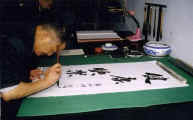 calligrapher
drew our names and wishes on rice paper, demonstrating this skill, which is
still very much alive in China. We left it to dry while we went off to a: calligrapher
drew our names and wishes on rice paper, demonstrating this skill, which is
still very much alive in China. We left it to dry while we went off to a: Kindergarten
- A visit 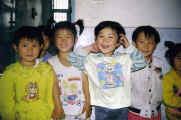 to a local kindergarten, where we and
the kids had fun with pictures, 'high fives', and singing. The
teachers were good-humored about the interruption and made our visit very
enjoyable. to a local kindergarten, where we and
the kids had fun with pictures, 'high fives', and singing. The
teachers were good-humored about the interruption and made our visit very
enjoyable. School for Deaf - A visit to a local school that educates deaf
and mute children; we liked one of the pictures painted by a student so much
that
they gave it to us, and we donated some funds to the student in return.
The
school seemed to be doing very good work, and was trying to expand their
facilities. Noodle Factory - A tour of a
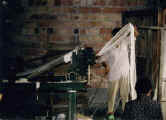 family-run noodle factory where 5
people turn 2000 Kg of flour into noodles each day with the aid of aging
machinery and ingenuity. They operate in a 1-room factory where they pour
flour into one end of a machine, and noodles pour out of the other end, to be
hung outside to dry. There were several factories in the neighborhood. family-run noodle factory where 5
people turn 2000 Kg of flour into noodles each day with the aid of aging
machinery and ingenuity. They operate in a 1-room factory where they pour
flour into one end of a machine, and noodles pour out of the other end, to be
hung outside to dry. There were several factories in the neighborhood. Tea
House - A tea house, where we shared tea (cheap!)
with many men, some in blue Mao suits, and women as they sipped tea, played
cards and MahJong. 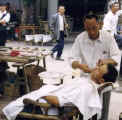 Just
outside was a street barber, taking customers from the passersby. Just
outside was a street barber, taking customers from the passersby.
Mah Jong - Finally,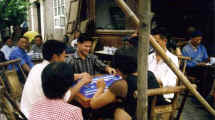 a Mah Jong lesson in a friend's
house, where we learned the basics and then were then pitted against the
lady of the house - we didn't stand a chance! a Mah Jong lesson in a friend's
house, where we learned the basics and then were then pitted against the
lady of the house - we didn't stand a chance!
This entire day cost only $US30 for both of us and was the
best
education we had about life in everyday China. Mr.
Yang also runs a small restaurant that serves outstanding Sichuan meals - we
recommend his trip and restaurant very highly.
Emei Shan
Our next stop was one of the 5 sacred Buddhist mountains
of China, a scenic area with strong religious significance. 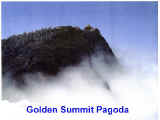 Buses
transport tourists to all scenic areas of the mountain, and some people stay at
the top to view the rising sun. We rode part way, watched the macaque monkeys
beg from the tourists (next to people selling monkey food were signs saying
"Don't Feed The Monkeys"), took photos of exotic temples and
pagodas, and then hopped the cable-car to the top. The Golden Summit
Monastery has views over the entire mountain, and the hand-railing on the
final 50 m is covered with locks, remnants of lovers who pledge their eternal
love with a lock, and throw the key away. In the town, we hung out at The Teddy
Bear Cafe, one of the few places in town with an English menu that caters to
Westerners, particularly backpackers. At the central bus station, brand new and
well marked, it proved easy to find a bus to our next destination, Chengdu. Buses
transport tourists to all scenic areas of the mountain, and some people stay at
the top to view the rising sun. We rode part way, watched the macaque monkeys
beg from the tourists (next to people selling monkey food were signs saying
"Don't Feed The Monkeys"), took photos of exotic temples and
pagodas, and then hopped the cable-car to the top. The Golden Summit
Monastery has views over the entire mountain, and the hand-railing on the
final 50 m is covered with locks, remnants of lovers who pledge their eternal
love with a lock, and throw the key away. In the town, we hung out at The Teddy
Bear Cafe, one of the few places in town with an English menu that caters to
Westerners, particularly backpackers. At the central bus station, brand new and
well marked, it proved easy to find a bus to our next destination, Chengdu.
Chengdu
Thrown out! - Our arrival in Chengdu was
memorable  - the bus driver signaled for us to get our stuff and come to the
front of the bus, pulled along the median strip and said something in Chinese
that seemed like: 'go that way'! So there we were, standing along a
busy highway with all of our bags and thinking, "OK, what do we do
now." We were rescued when a taxi stopped; we quickly hopped in and
pointed to the Mandarin characters of the address of our hotel in the Lonely
Planet Guide. Ten minutes later we were checking into the Tibet
Hotel,
where they spoke even less English than the bus driver. The highlight of
this city is the The Giant Panda Research Base. The base has 14-20 pairs
of pandas, which they breed for research and foreign zoos. We were able
to get within a couple of feet of these teddy bears, and watch them munch on
bamboo - their favorite food, which is pretty much all that they do. They
are even less active than the Koala bears in Australia. Later on
while wandering the streets we found an Internet cafe,
with a blazingly fast connection that downloaded pages in 2-3 seconds - all for $0.25/hour. The next day we caught a flight to what we hoped
would be a fantastic scenic area: Zhangjiajie.
- the bus driver signaled for us to get our stuff and come to the
front of the bus, pulled along the median strip and said something in Chinese
that seemed like: 'go that way'! So there we were, standing along a
busy highway with all of our bags and thinking, "OK, what do we do
now." We were rescued when a taxi stopped; we quickly hopped in and
pointed to the Mandarin characters of the address of our hotel in the Lonely
Planet Guide. Ten minutes later we were checking into the Tibet
Hotel,
where they spoke even less English than the bus driver. The highlight of
this city is the The Giant Panda Research Base. The base has 14-20 pairs
of pandas, which they breed for research and foreign zoos. We were able
to get within a couple of feet of these teddy bears, and watch them munch on
bamboo - their favorite food, which is pretty much all that they do. They
are even less active than the Koala bears in Australia. Later on
while wandering the streets we found an Internet cafe,
with a blazingly fast connection that downloaded pages in 2-3 seconds - all for $0.25/hour. The next day we caught a flight to what we hoped
would be a fantastic scenic area: Zhangjiajie.
|